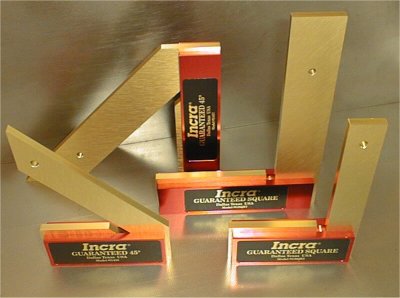|
|
|
If you were to search for
squares to use in the woodworking shop what you would find are carpenters speed squares,
carpenters framing squares, try, machinists, double, combination, and a line of
exceedingly expensive collectors tools. |
 |
| Construction The line of Incra Guaranteed Squares include two types and two sizes for a total of four to choose from. All are made from tempered aluminum 0.25" thick. The blade and body (the gold part) is milled from a single piece and the base has two extra slabs of aluminum attached to it. Overall, the construction is simple and robust; this should help maintain its accuracy. Square Theory Anyone who has tested framing squares in the store in order to find a good one knows that just because something says it's a "square", doesn't mean that it IS square. More correctly, it may not be "square enough" for our use. Everything made by the hand of man has a tolerance whether it be known or not; this of coarse holds true for squares. I've never seen a tolerance for carpenters squares, it's probably because they are cheap consumer grade goods - we already know they are not particularly square, at least to us. Squares used by machinists on the other hand are offered in different accuracy grades with published tolerances. A lot of us use common grade machinists, double, and combination squares in our shops. Generally these have a squareness tolerance of about +/- 0.004" (within 8 thousandths) or so. This is nearly always good enough for layout work and usually for machine setups too. These tools are still not optimized for our purposes though. The published tolerances of the Incra squares is +/-0.001" over the entire length of the blade, this is a step above the common grade of machinists tools. So what's 0.002" here or there? If you have the opportunity to test the difference by holding the Incra square to the square you usually use I think the answer may surprise you. Accuracy It's very easy to test to see if a square is "in the ballpark", it's quite another to test something that appears to be within 0.002", you simply cannot use very convenient means; it takes either another square of remarkably superior accuracy or special setups. I used an "amplification" method to measure the Incra. Basically what I found was that it's at least as square as they say it is and due to the construction I believe it will stay that way. I even had some difficulty doing a "photon" test on the edges which says a lot about the tool to me. Layout For layout work, I don't think you'll see where the added accuracy of the Incra comes into play. Our layout marks are pretty big compared to the tolerances. What you WILL see is the increased usability. First off, the blade itself is super thick compared to other tools. At ¼" it is thick enough for stock to register against it. Anyone who has tried to place a thin square blade against the corner or a rounded over work pieces will appreciate this benefit. After using a thick blade like this for a while every other bladed square I have feels sort of puny and insubstantial by comparison. One will also notice that the base is held away from the inner edge by a bit. This allows the base to act as a ledge to hold the square while in use which keeps the base from swinging down. There is one minor shop annoyance solved right there. Like some machinist squares, the Inca has a notch in the inside corner to allow for accurate use if burrs / splinter are present on the work piece. Unlike a machinist square however the clearance notch is big enough for our woodworking purposes. Setups For machine setups I think you probably WILL see an accuracy improvement offered by the Incra. After doing some cursory machine checks with the Incra, I discovered some things weren't quite as square as I thought they were. Depending upon the situation, this may or may not have an influence on a joint or project. The point is that if nothing else you can know to a finer degree if a setup is square or not - knowledge is a powerful tool in itself. The Incra squares can also be used as your "last word" reference, it's probably unlikely that you would own anything else more square than it. Conclusion Even though the high accuracy of the Incra for layout work is probably overkill, it's optimized woodworking features offer definite usability improvements for us. For machine setups and reference work, it provides remarkable accuracy. This should help you out quite a bit in the shop when it comes to producing accurate joints.
In the interest of full disclosure, Incra provided this product to facilitate this review.
|